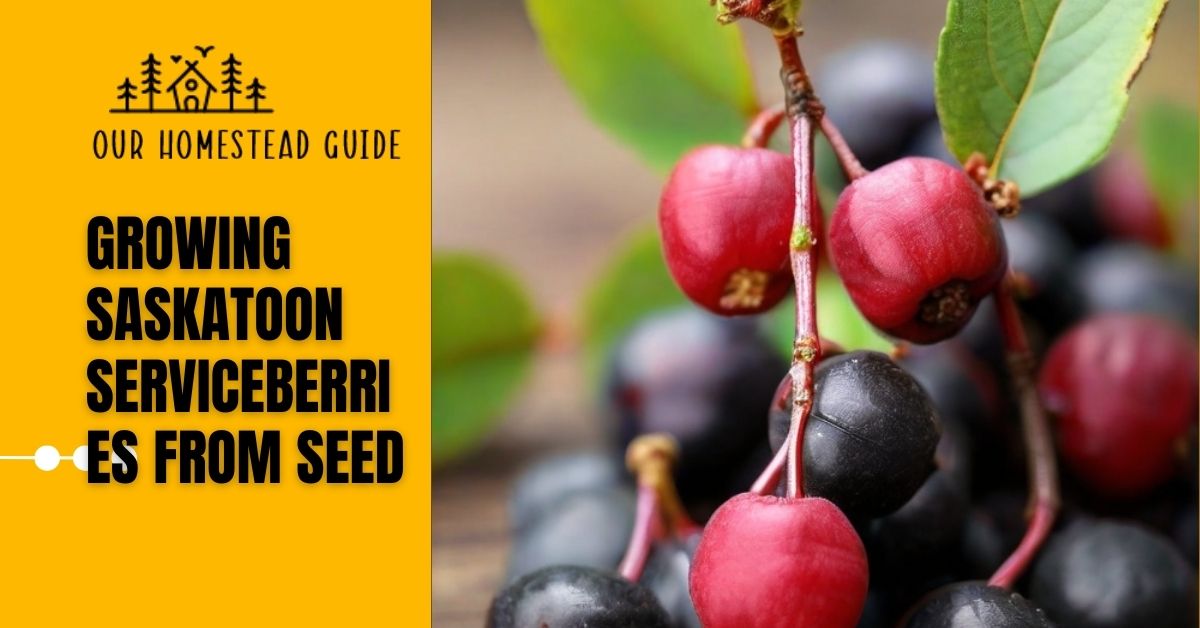Plant guide for growing Saskatoon serviceberries from seed: Easy Steps
Both novice and experienced gardeners can find joy in growing Saskatoon serviceberries from seed. This native North American shrub, prized for its delicious and nutritious berries, begins with the collection of ripe seeds in late summer or early fall.
Cultivating Saskatoon serviceberries from seeds involves essential steps, from careful seed extraction to creating optimal conditions for germination and growth. In this tutorial, we’ll explore the process, offering valuable insights at each stage of this fulfilling gardening journey. Whether you aim to enhance garden biodiversity, create a natural habitat, or savor homegrown berries, this guide provides your gateway to success.
How to growing Saskatoon serviceberries from seed?
1. Gather Your Materials
Before you begin, make sure you have the following items ready:
- Saskatoon berry seeds
- Rubbermaid container with a lid
- Seedling mat
- Plant tray
- Potting soil
- Watering can
2. Understand the Stratification Process Growing saskatoon serviceberry from seed
When developing Saskatoon berry seeds, understanding the stratification process is key since it helps break their dormancy and encourage effective germination. The cold stratification phase and the warm stratification phase are the two separate stages of this process. The circumstances that the seeds would encounter during these phases are similar to those found in their natural habitat.
1-Cold Stratification Phase:
The cleansed Saskatoon berry seeds are initially stored in a container during the cold stratification phase, frequently with a moist medium like peat moss, sand, or a damp paper towel. The seeds are maintained in a refrigerator for a predetermined amount of time, usually between 90 and 120 days, in a sealed container. The seeds’ dormancy is broken and they are primed for germination by the cold and wet circumstances that mimic winter.
2-Warm Stratification Phase
Growing saskatoon serviceberry from seed The seeds are moved to a warm environment after the cold stratification phase. They are taken out of the fridge and kept heated, often at room temperature, for a shorter time, usually a few weeks. This phase simulates spring conditions, signaling to the seeds that it’s time to start growing.
3. Prepare the Container
Growing saskatoon serviceberry from seed A critical step in assuring effective germination of your Saskatoon berry seeds is preparing the container. To provide your little seeds with the best environment possible, follow these steps:
a. To start, fill the bottom of the Rubbermaid container with potting soil. Verify that the ground is damp but not soggy. Growing saskatoon serviceberry from seed To ensure seed germination, moisture is necessary.
c. Evenly distribute your small Saskatoon berry seeds over the soggy ground. Growing saskatoon serviceberry from seed Because these seeds are so tiny, be careful and exact in this step to spread them uniformly.
c. Add another layer of potting soil on top of the seeds, gently breaking up any clumps to ensure even coverage. Growing saskatoon serviceberry from seed The seeds will benefit from this layer’s protection and stable growing environment.
c. Lightly mist the soil with water to let the seeds sink into it. Growing saskatoon serviceberry from seed Avoid overwatering as too much moisture might cause problems like damping off. As the seeds begin to germinate, make sure the soil is regularly wet but not soggy.
4. Label and Cover
a. Write “60-Day Warm / 120-Day Cold” on the Rubbermaid container’s lid to easily identify the stratification stages and their corresponding timespans. You may maintain track of the procedure and guarantee that you know when to transfer the seeds by labeling.
b. Firmly attach the container’s lid. You may give your Saskatoon berry seeds a contained, regulated environment by closing the container. Growing saskatoon serviceberry from seed Throughout the stratification phase, it is essential to maintain the ideal temperature and moisture conditions in order to support optimal germination.
5. Warm Moist Stratification
a. To start, choose a suitable spot for your seedling mat and put it up there. Keep the environment at a constant 70–80°F (2–27°C) temperature. Growing saskatoon serviceberry from seed This simulates the warm period needed for Saskatoon berry seed germination.
b. Place the seedling mat on top of the prepared container containing the Saskatoon berry seeds. Growing saskatoon serviceberry from seed Ensure that it stays in a low-light or dark setting throughout this period. For the growth of seeds, darkness is essential.
b. Permit the seeds to spend 60 days in this warm, humid stratification period. The circumstances that trigger the seeds to start germination are replicated throughout this time. To ensure that the container is continually moist, keep a close check on the moisture level, but don’t overwater to avoid problems like mold growth.
6. Cold Moist Stratification
A. Growing saskatoon serviceberry from seed It’s time to move your Saskatoon berry seeds into the cold phase, replicating late winter temperatures, after the 60-day warm phase.
a. Transfer the container containing the seeds to a refrigerator with a constant temperature of 32 to 40 degrees Fahrenheit (0 to 4 degrees Celsius). Growing saskatoon serviceberry from seed The stratification process must be completed in this chilly atmosphere.
c. Growing saskatoon serviceberry from seed Permit the seeds to spend a total of 120 days in the cold stratification period. Growing saskatoon serviceberry from seed The seeds will go through the required cooling hours during this time, which are essential for bringing them out of dormancy and getting them ready for effective germination.
7. Germination
a. You can start the germination process for your Saskatoon berry seeds after the 180-day stratification phase (60 days warm, 120 days cold).
c. Transfer the stratified seeds to a planting tray or individual pots with well-draining soil that are appropriate for the task. Growing saskatoon serviceberry from seed The delicate seedlings should not be harmed at this process, so proceed with caution.
c. Maintain a constant moisture level in the soil that is not wet. Make sure the soil is still wet because watering is necessary to start germination. Growing saskatoon serviceberry from seed To avoid jarring the seeds, use a spray bottle or a light watering can.
8. Patience and Updates
Although growing Saskatoon serviceberries from seed requires patience, the results are worthwhile. Growing saskatoon serviceberry from seed Keep a close eye on your seedlings’ development as they grow throughout time to make sure they get the attention they require.
You may start the process of transplanting your Saskatoon serviceberry seedlings to your preferred place on your farm once they have grown to an appropriate size and vigor. Growing saskatoon serviceberry from seed They will grow here and eventually provide berries for you to enjoy that are tasty and healthful.
Information Table
The following table provides information about “Growing Saskatoon Serviceberry from Seed”:
| Aspect | Information |
| Seed Selection | Choose fresh, ripe Saskatoon Serviceberry seeds. Look for plump, healthy seeds with no signs of damage or mold. |
| Seed Stratification | Cold stratify the seeds for 90-120 days by placing them in a damp paper towel inside a plastic bag in the refrigerator. This mimics winter conditions and promotes germination. |
| Germination | Plant the stratified seeds in a seed starting mix in pots or trays. Keep them moist and warm (around 70°F or 21°C) to encourage sprouting. Expect germination in 2-3 weeks. |
| Transplanting | When seedlings have 2-4 leaves, transplant them into individual pots. Ensure good drainage in the soil and provide adequate light. |
| Outdoor Planting | Wait until seedlings are well-established and outdoor temperatures are consistently above freezing before transplanting them into a sunny location in your garden. Space plants 4-6 feet apart. |
| Watering and Fertilizing | Keep the soil consistently moist but not waterlogged. Apply a balanced, slow-release fertilizer in spring and mulch to retain moisture. |
| Pruning | Prune to remove weak or damaged branches during the dormant season (winter). Minimal pruning is required once the tree is established. |
| Pest and Disease Management | Regularly inspect for common pests like aphids and treat as necessary. Watch for signs of fungal diseases and apply fungicides if needed. |
| Harvesting | Saskatoon Serviceberries are typically ready for harvest in early summer. Harvest ripe berries by gently picking them from the bush. |
| Maintenance | Provide ongoing care, including watering during dry periods, and monitor the health of your Saskatoon Serviceberry tree as it grows. |
Being a suckering plant, saskatoon serviceberry is simpler to spread. It sort of does most of the work for you.
Rhizomes, from which new plants can be produced, are spontaneously sent forth by Saskatoon serviceberry plants. Digging around the sucker and separating it from the main root is the best way to reproduce these kinds of plants.
Nutrition and Health Benefits
1-Nutritional Value
Saskatoon berries, commonly referred to as Juneberries or serviceberries, are incredibly nutritious. Growing saskatoon serviceberry from seed They are a beneficial addition to your diet since they are packed with several key elements and antioxidants. The breakdown of their nutritional value is as follows:
Vitamins
Saskatoon berries include vitamins including vitamin C, which supports collagen synthesis and strengthens your immune system, and vitamin K, which is crucial for blood clotting and bone health.
Minerals
Growing saskatoon serviceberry from seed These berries are a good source of important minerals including potassium, magnesium, and manganese, which support strong bones, a healthy heart, and healthy muscles.
Dietary Fiber
Growing saskatoon serviceberry from seed Saskatoon berries are a rich source of dietary fiber, which helps to maintain healthy digestion and control blood sugar levels.
Antioxidants
They are abundant in antioxidants including anthocyanins, quercetin, and rutin that defend cells from oxidative damage and lower the chance of developing chronic illnesses.
Protein
Growing saskatoon serviceberry from seed Although not a substantial quantity, Saskatoon berries do include a tiny amount of protein, which helps with overall nutrition.
2-Health Benefits
Saskatoon berries provide a number of health advantages:
Antioxidant Protection
Growing saskatoon serviceberry from seed The dietary fiber in Saskatoon berries supports a healthy digestive tract and encourages regular bowel motions while preventing constipation.
Heart Health
Growing saskatoon serviceberry from seed High antioxidant content of Saskatoon berries helps the body fight off free radicals, which lowers the risk of chronic illnesses including cancer, heart disease, and neurological disorders.
Cardiovascular Health
These berries’ potassium content maintains normal blood pressure levels and lowers the risk of stroke and cardiovascular disorders.
Effects on Inflammation
These berries include several substances that have anti-inflammatory qualities that can help reduce the symptoms of inflammatory diseases like arthritis.
Bone Health
Minerals like manganese and vitamin K are necessary for strong, healthy bones.
Weight control
Saskatoon berries’ fiber makes you feel satisfied and full, which may assist with weight management by preventing overeating.
Support for the Immune System
The vitamin C in these berries strengthens the immune system and aids the body in warding off illnesses.
Eye Health
Antioxidants like anthocyanins may help to protect against age-related vision issues and enhance eye health.
Serving Ideas
Effects on Inflammation: These berries include several substances that have anti-inflammatory qualities that can help reduce the symptoms of inflammatory diseases like arthritis.
Bone Health: Minerals like manganese and vitamin K are necessary for strong, healthy bones.
Weight control: Saskatoon berries’ fiber makes you feel satisfied and full, which may assist with weight management by preventing overeating.
Support for the Immune System: The vitamin C in these berries strengthens the immune system and aids the body in warding off illnesses.
Antioxidants like anthocyanins may help to protect against age-related vision issues and enhance eye health.
Salads: Add Saskatoon berries for a sweet and bitter contrast to salads. They work excellent in a summer salad with spinach, goat cheese, and almonds.
Sauces: To serve with meats like pork or chicken, cook Saskatoon berries into a sauce. Their inherent sweetness counteracts the savoury tastes.
sweets: Make delectable sweets like crisps, cobblers, or fruit tarts with Saskatoon berries. They can also be included in yogurt or ice cream parfaits.
Conclusion
You now have a thorough manual for growing Saskatoon serviceberries from seed, including information on stratification and transplanting. With perseverance and the right stratification method, you may reap a plentiful harvest of these delicious berries. I wish you success with your Saskatoon serviceberry garden and happy gardening!
Most Frequently Asked Questions!
1. What is Saskatoon serviceberry, and why grow it from seed?
The fruit-bearing shrub known as the saskatoon serviceberry (Amelanchier alnifolia) is indigenous to North America. You may grow this unusual and delicious berry shrub from seed in your yard. In addition, purchasing plants this manner is less expensive than purchasing existing bushes.
2. When is the best time to plant Saskatoon serviceberry seeds?
Saskatoon serviceberry seeds should be planted in the autumn or early spring when they are naturally stratified (exposed to cold weather) to break dormancy.
3. How do I prepare Saskatoon serviceberry seeds for planting?
Saskatoon serviceberry seeds may be cold-stratified by putting them in a moist paper towel or peat moss inside a closed plastic bag and keeping them there for 60 to 90 days. This simulates their typical winter weather.
4. What type of soil is best for growing Saskatoon serviceberry from seed?
Well-drained, slightly acidic to neutral soil is ideal for Saskatoon serviceberries. Ideal soils have a high organic matter content and are loamy or sandy.
5. Can I plant Saskatoon serviceberry seeds directly in the garden, or should I use pots or trays?
For better control over germination, you can start the seeds inside or in a greenhouse in trays or pots. You may transfer them into your garden once they have grown into strong seedlings.
6. How deep should I plant Saskatoon serviceberry seeds?
Place the seeds in the soil or growth media between 1/4 and 1/2 inch deep.
7. What kind of light do Saskatoon serviceberry seedlings need?
For optimum growth, Saskatoon serviceberry seedlings need full sun to moderate shade. Make sure they get 6 to 8 hours of sunlight each day.
8. How often should I water Saskatoon serviceberry seedlings?
Maintain a constant moisture level in the soil that is not wet. When the top inch of soil seems dry, water the seedlings.
9. When can I expect Saskatoon serviceberry seeds to germinate and produce fruit?
It is well known that Saskatoon serviceberries grow slowly. Your plants may not begin to bear fruit for some years, usually between two and five years after planting.
10. Do Saskatoon serviceberry plants require any special care as they mature?
Saskatoon serviceberry bushes require little care once they reach maturity. To form the shrub and get rid of weak or dead branches, prune them in late winter or early spring. They often have pest and disease resistance.
11. Can I grow Saskatoon serviceberries in containers?
Yes, Saskatoon serviceberries may be grown in large pots or containers. Use a premium potting mix and ensure the container has sufficient drainage. Plants grown in containers can need more frequent fertilizer and watering.
12. Are Saskatoon serviceberries self-pollinating, or do I need multiple plants for cross-pollination?
Although Saskatoon serviceberries may partially self-fertilize, cross-pollination improves fruit output. Planting many different cultivars can boost harvests.
you may also like this article.
10 Easy Ways of Growing Habanero Peppers Indoors: step by step



